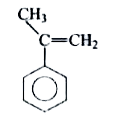What are the reagents used in Hofmann reaction? What is the organic product ?
Step-by-Step Solution:
1. Identify the Reaction: The Hofmann reaction involves the conversion of an amide to a primary amine with the loss of one carbon atom.
2. Reagents Used: The reagents for the Hofmann reaction include:
- Halogen (Cl2 or Br2)
- Aqueous sodium hydroxide (NaOH) or potassium hydroxide (KOH)
3. Starting Material: The starting material for the Hofmann reaction is an amide, which has the general structure R-C(=O)-NH2.
4. Mechanism Overview:
- The amide reacts with a base (NaOH or KOH), which deprotonates the amide nitrogen, forming a negatively charged nitrogen species (R-C(=O)-NH-).
- This negatively charged nitrogen then reacts with the halogen (Br2 or Cl2), leading to the formation of an N-haloamide (R-C(=O)-NBr).
- The N-haloamide undergoes further reaction with the base, leading to the formation of isocyanate (R-N=C=O).
- Finally, the isocyanate reacts with water to yield a primary amine (R-NH2) and carbon dioxide (CO2) is eliminated upon heating.
5. Organic Product: The final organic product of the Hofmann reaction is a primary amine (R-NH2).
Summary of the Reaction:
The overall reaction can be summarized as:
R−C(=O)−NH2+Cl2/Br2+NaOH/KOH→R−NH2+by-products
- Halogen (Cl2 or Br2)
- Aqueous sodium hydroxide (NaOH) or potassium hydroxide (KOH)
- The amide reacts with a base (NaOH or KOH), which deprotonates the amide nitrogen, forming a negatively charged nitrogen species (R-C(=O)-NH-).
- This negatively charged nitrogen then reacts with the halogen (Br2 or Cl2), leading to the formation of an N-haloamide (R-C(=O)-NBr).
- The N-haloamide undergoes further reaction with the base, leading to the formation of isocyanate (R-N=C=O).
- Finally, the isocyanate reacts with water to yield a primary amine (R-NH2) and carbon dioxide (CO2) is eliminated upon heating.
The overall reaction can be summarized as:
R−C(=O)−NH2+Cl2/Br2+NaOH/KOH→R−NH2+by-products
Topper's Solved these Questions
- ORGANIC COMPOUNDS CONTAINING NITROGENBOOK - ICSECHAPTER - ORGANIC COMPOUNDS CONTAINING NITROGENEXERCISE - EXERCISE (PART-II DESCRIPTIVE QUESTIONS- SHORT ANSWER QUESTIONS )
92 Videos
- ORGANIC COMPOUNDS CONTAINING NITROGENBOOK - ICSECHAPTER - ORGANIC COMPOUNDS CONTAINING NITROGENEXERCISE - EXERCISE (PART-II DESCRIPTIVE QUESTIONS- LONG ANSWER QUESTIONS )
57 Videos
- ORGANIC COMPOUNDS CONTAINING NITROGENBOOK - ICSECHAPTER - ORGANIC COMPOUNDS CONTAINING NITROGENEXERCISE - EXERCISE (PART-I OBJECTIVE QUESTIONS)
72 Videos
- ISC QUESTION PAPERBOOK - ICSECHAPTER - ISC QUESTION PAPEREXERCISE - PART-II(SECTION-B)
74 Videos
- P-BLOCK ELEMENTSBOOK - ICSECHAPTER - P-BLOCK ELEMENTSEXERCISE - SOURCE BASED QUESTIONS
10 Videos
Similar Questions
Knowledge Check
In the given reaction, what is the product ?
 A
A B
B C
C D
D
 reagent are used for the reaction :ALiAlH4BH2/NiCNaBH4DH2,Pd−BaSO4
reagent are used for the reaction :ALiAlH4BH2/NiCNaBH4DH2,Pd−BaSO4
Hofmann elimination reaction.
View SolutionThe reagent used for Friedel-Craft's reaction is :
View SolutionWhich reagent is used to detect hydrogen in an organic compound ?
View SolutionWhat are the major product of following reaction ?

View SolutionWhat is the product of this sequence of reactions ?

View SolutionWhat are the major products in the following reaction:
_E01_270_Q01.png)
View Solution
